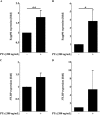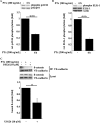Pertussis Toxin Exploits Specific Host Cell Signaling Pathways for Promoting Invasion and Translocation of Escherichia coli K1 RS218 in Human Brain-derived Microvascular Endothelial Cells
- PMID: 26324705
- PMCID: PMC4598994
- DOI: 10.1074/jbc.M115.650101
Pertussis Toxin Exploits Specific Host Cell Signaling Pathways for Promoting Invasion and Translocation of Escherichia coli K1 RS218 in Human Brain-derived Microvascular Endothelial Cells
Abstract
Pertussis toxin (PTx), an AB5 toxin and major virulence factor of the whooping cough-causing pathogen Bordetella pertussis, has been shown to affect the blood-brain barrier. Dysfunction of the blood-brain barrier may facilitate penetration of bacterial pathogens into the brain, such as Escherichia coli K1 (RS218). In this study, we investigated the influence of PTx on blood-brain barrier permissiveness to E. coli infection using human brain-derived endothelial HBMEC and TY10 cells as in vitro models. Our results indicate that PTx acts at several key points of host cell intracellular signaling pathways, which are also affected by E. coli K1 RS218 infection. Application of PTx increased the expression of the pathogen binding receptor gp96. Further, we found an activation of STAT3 and of the small GTPase Rac1, which have been described as being essential for bacterial invasion involving host cell actin cytoskeleton rearrangements at the bacterial entry site. In addition, we showed that PTx induces a remarkable relocation of VE-cadherin and β-catenin from intercellular junctions. The observed changes in host cell signaling molecules were accompanied by differences in intracellular calcium levels, which might act as a second messenger system for PTx. In summary, PTx not only facilitates invasion of E. coli K1 RS218 by activating essential signaling cascades; it also affects intercellular barriers to increase paracellular translocation.
Keywords: Bordetella pertussis; Escherichia coli (E. coli); VE-cadherin; beta-catenin (B-catenin); endothelial dysfunction; pertussis toxin; translocation.
© 2015 by The American Society for Biochemistry and Molecular Biology, Inc.
Figures








Similar articles
-
Pertussis Toxin Exploits Host Cell Signaling Pathways Induced by Meningitis-Causing E. coli K1-RS218 and Enhances Adherence of Monocytic THP-1 Cells to Human Cerebral Endothelial Cells.Toxins (Basel). 2016 Oct 13;8(10):291. doi: 10.3390/toxins8100291. Toxins (Basel). 2016. PMID: 27754355 Free PMC article.
-
IbeA and OmpA of Escherichia coli K1 exploit Rac1 activation for invasion of human brain microvascular endothelial cells.Infect Immun. 2012 Jun;80(6):2035-41. doi: 10.1128/IAI.06320-11. Epub 2012 Mar 26. Infect Immun. 2012. PMID: 22451524 Free PMC article.
-
Pertussis toxin permeabilization enhances the traversal of Escherichia coli K1, macrophages, and monocytes in a cerebral endothelial barrier model in vitro.Int J Med Microbiol. 2011 Mar;301(3):204-12. doi: 10.1016/j.ijmm.2010.08.018. Epub 2010 Nov 5. Int J Med Microbiol. 2011. PMID: 21115396
-
Invasion processes of pathogenic Escherichia coli.Int J Med Microbiol. 2005 Oct;295(6-7):463-70. doi: 10.1016/j.ijmm.2005.07.004. Int J Med Microbiol. 2005. PMID: 16238020 Review.
-
Current concepts on Escherichia coli K1 translocation of the blood-brain barrier.FEMS Immunol Med Microbiol. 2004 Nov 1;42(3):271-9. doi: 10.1016/j.femsim.2004.09.001. FEMS Immunol Med Microbiol. 2004. PMID: 15477040 Review.
Cited by
-
Pertussis Toxin Exploits Host Cell Signaling Pathways Induced by Meningitis-Causing E. coli K1-RS218 and Enhances Adherence of Monocytic THP-1 Cells to Human Cerebral Endothelial Cells.Toxins (Basel). 2016 Oct 13;8(10):291. doi: 10.3390/toxins8100291. Toxins (Basel). 2016. PMID: 27754355 Free PMC article.
-
Wnt/β-Catenin Signaling as a Molecular Target by Pathogenic Bacteria.Front Immunol. 2019 Sep 27;10:2135. doi: 10.3389/fimmu.2019.02135. eCollection 2019. Front Immunol. 2019. PMID: 31611869 Free PMC article. Review.
-
Cronobacter sakazakii ATCC 29544 Translocated Human Brain Microvascular Endothelial Cells via Endocytosis, Apoptosis Induction, and Disruption of Tight Junction.Front Microbiol. 2021 Jun 7;12:675020. doi: 10.3389/fmicb.2021.675020. eCollection 2021. Front Microbiol. 2021. PMID: 34163451 Free PMC article.
-
Design and Validation of a Human Brain Endothelial Microvessel-on-a-Chip Open Microfluidic Model Enabling Advanced Optical Imaging.Front Bioeng Biotechnol. 2020 Sep 28;8:573775. doi: 10.3389/fbioe.2020.573775. eCollection 2020. Front Bioeng Biotechnol. 2020. PMID: 33117784 Free PMC article.
-
CCL2 Is a Vascular Permeability Factor Inducing CCR2-Dependent Endothelial Retraction during Lung Metastasis.Mol Cancer Res. 2019 Mar;17(3):783-793. doi: 10.1158/1541-7786.MCR-18-0530. Epub 2018 Dec 14. Mol Cancer Res. 2019. PMID: 30552233 Free PMC article.
References
-
- Geier D. A., Geier M. R. (2004) An evaluation of serious neurological disorders following immunization: a comparison of whole-cell pertussis and acellular pertussis vaccines. Brain Dev. 26, 296–300 - PubMed
-
- Heininger U., Kleemann W. J., Cherry J. D., and Sudden Infant Death Syndrome Study Group (2004) A controlled study of the relationship between Bordetella pertussis infections and sudden unexpected deaths among German infants. Pediatrics 114, e9–e15 - PubMed
-
- Grant C. C., McKay E. J., Simpson A., Buckley D. (1998) Pertussis encephalopathy with high cerebrospinal fluid antibody titers to pertussis toxin and filamentous hemagglutinin. Pediatrics 102, 986–990 - PubMed
-
- Seidel G., Böcker K., Schulte J., Wewer C., Greune L., Humberg V., Schmidt M. A. (2011) Pertussis toxin permeabilization enhances the traversal of Escherichia coli K1, macrophages, and monocytes in a cerebral endothelial barrier model in vitro. Int. J. Med. Microbiol. 301, 204–212 - PubMed
-
- Brückener K. E., el Bayâ A., Galla H. J., Schmidt M. A. (2003) Permeabilization in a cerebral endothelial barrier model by pertussis toxin involves the PKC effector pathway and is abolished by elevated levels of cAMP. J. Cell Sci. 116, 1837–1846 - PubMed
Publication types
MeSH terms
Substances
Grants and funding
LinkOut - more resources
Full Text Sources
Research Materials
Miscellaneous

